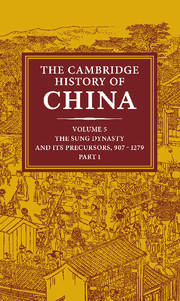Book contents
- Frontmatter
- Introduction: the Sung Dynasty and Its Precursors, 907–1279
- 1 The Five Dynasties
- 2 The Southern Kingdoms between the T’ang and the Sung, 907–979
- 3 Founding and Consolidation of the Sung Dynasty under T’ai-tsu (960–976), T’ai-tsung (976–997), and Chen-tsung (997–1022)
- 4 The Reigns of Jen-tsung (1022–1063) and Ying-tsung (1063–1067)
- 5 Shen-tsung’s Reign and the New Policies of Wang An-shih, 1067–1085
- 6 Che-tsung’s Reign (1085–1100) and the Age of Faction
- 7 The Reigns of Hui-tsung (1100–1126) and Ch’in-tsung (1126–1127) and the Fall of the Northern Sung
- 8 The Move to the South and the Reign of Kao-tsung (1127–1162)
- 9 The Reign of Hsiao-tsung (1162–1189)
- 10 The Reigns of Kuang-tsung (1189–1194) and Ning-tsung (1194–1224)
- 11 The Reign of Li-tsung (1224–1264)
- 12 The Reign of Tu-tsung (1264–1274) and His Successors to 1279
- Bibliography
- Glossary–Index
- References
11 - The Reign of Li-tsung (1224–1264)
Published online by Cambridge University Press: 28 March 2010
- Frontmatter
- Introduction: the Sung Dynasty and Its Precursors, 907–1279
- 1 The Five Dynasties
- 2 The Southern Kingdoms between the T’ang and the Sung, 907–979
- 3 Founding and Consolidation of the Sung Dynasty under T’ai-tsu (960–976), T’ai-tsung (976–997), and Chen-tsung (997–1022)
- 4 The Reigns of Jen-tsung (1022–1063) and Ying-tsung (1063–1067)
- 5 Shen-tsung’s Reign and the New Policies of Wang An-shih, 1067–1085
- 6 Che-tsung’s Reign (1085–1100) and the Age of Faction
- 7 The Reigns of Hui-tsung (1100–1126) and Ch’in-tsung (1126–1127) and the Fall of the Northern Sung
- 8 The Move to the South and the Reign of Kao-tsung (1127–1162)
- 9 The Reign of Hsiao-tsung (1162–1189)
- 10 The Reigns of Kuang-tsung (1189–1194) and Ning-tsung (1194–1224)
- 11 The Reign of Li-tsung (1224–1264)
- 12 The Reign of Tu-tsung (1264–1274) and His Successors to 1279
- Bibliography
- Glossary–Index
- References
Summary
shih mi-yüan in isolation
The sudden elevation of Chao Yün (1205–64) to imperial son only five days before the death of Emperor Ning-tsung and the replacing of Chao Hung as heir to the throne might have turned the Sung court into a battlefield of warring factions. Instead, this irregular transfer of power took place initially without incident. No mutiny erupted among the guards assigned to protect Chao Hung. The guards were forcibly detained outside the palace on the night of Ning-tsung’s death and thereby denied any opportunity to interrupt the accession. Imperial clansmen living away from Lin-an raised no armies to lead against the capital with a pledge to restore the throne to its rightful occupant. The bureaucracy was also muted in its response. No one attempted to assassinate the chief councilor, Shih Mi-yüan, for his leading role in the controversial succession. There was no repeat of the Han T’o-chou incident. Students at the Imperial University proved uncharacteristically quiet. No indictments were submitted against powerful ministers exceeding their authority. The political elite, if not regarding the succession as legitimate, found it expedient to confine its suspicions and gossip to private quarters. Even the hot-tempered Chao Hung seems to have passively accepted his fate. He made no attempt to turn the bureaucracy against Shih Mi-yüan, its increasingly unpopular chief. The new emperor, known to history as Li-tsung, opted against a distant exile for his adoptive brother. Chao Hung was quickly moved to the quiet, scenic fishing town of Hu-chou, where he probably enjoyed considerable freedom of movement.
- Type
- Chapter
- Information
- The Cambridge History of China , pp. 839 - 912Publisher: Cambridge University PressPrint publication year: 2009
References
- 1
- Cited by

